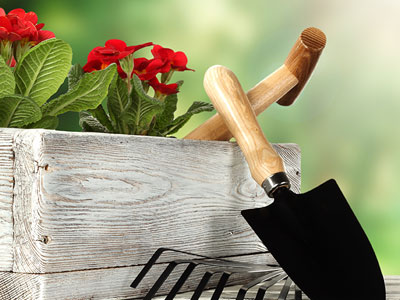Monthly Gardening Advice – June

JUNE
Lawncare
- Mow the lawn weekly and remember to add the clippings to your compost heap.
- Continue to apply liquid high nitrogen fertiliser to keep the lawn looking healthy if not done last month.
- Disperse dry worm casts with hard bristled broom.
- During dry periods cut the lawn a little longer and invest in a mulching mower to help the lawn retain moisture.
- Apply a selective weed-killer to lawns, which kill weeds but not the lawn, remember to check bulbs have died down and it may kill wild flowers.
- Move garden furniture and objects round the lawn regularly to prevent yellow patches.
Houseplant Care
- Increase the watering and begin liquid feeding.
- Re-pot houseplants which show signs of being root-bound and give plants more space as they grow to prevent pest and disease..
- Make sure the area is well ventilated.
- Move plants like citrus and cymbidiums outside on warm days and bring in if a chilly night is forecast.
- Apply shade paint to the outside of the glass or use blinds on sunny days to prevent temperatures soaring.
Jobs To Do In The Garden
- Plant out summer bedding.
- Inspect lilies for scarlet lily beetles.
- Stake and tie tall or floppy plants.
- Prune overcrowded dead or diseased stems from clematis montana once finished flowering.
- Mulch around shrubs, roses and trees to help prevent moisture loss and to suppress weeds.
- Pinch out leading shoots on chrysanthemums, helianthus to encourage bushy plants.
- Prune spring flowers shrubs once they have finished flowering (forsythia, spiraea, berberis and ribes)
- Sweet peas can be trained onto their support to create a good display.
- Fill gaps in borders with annuals.
- Take cuttings of pinks (dianthus).
- Dead-head pansies, violas and primulas.
- Position summer baskets and containers outside.
- Trim back dead bulb foliage if not already done.
- Make sure tubs, hanging baskets and troughs are well watered. Use collected rainwater, or recycled grey water whenever possible.
- Hoe borders to prevent annual and perennial weeds from establishing in the border.
- Check for first signs of blackspot, aphid and rolling sawfly on roses.
Jobs To Do The Greenhouse
- Keep the temperature in the greenhouse at 5°C for fuchsia and geraniums and a warmer 12°C for topical plants.
- Remember to ventilate greenhouse on sunny days and on the warmest days you may need to damp the flooring down to increase the humidity.
- Check seedlings for damping off, which can be a problem under glass (if it becomes a problem treat with Cheshunt Compound).
- Give plants more space as they grow to help avoid pest infestations.
- Soft tip Fuchsia cuttings can be taken this month.
- Check for vine weevil larvae in containers. Treat with a suitable pest killer if present.
- Harden off half-hardy annuals, which have been started undercover and need acclimatising to the outside environment over a period of a week or so ready for planting in their final position.
- Use shade paint on the outside of greenhouses or use blinds to stop temperatures soaring
- Check plants regularly for water.
- Regularly inspect plants for pest and disease.
The Vegetable Garden
- Continue to sow beetroot, pak choi and radish.
- Sow broad beans, runner beans, peas, sweetcorn and outdoor cucumber direct into prepared beds.
- Plant out tomatoes – remember to remove side shoots.
- Change to high potash feed for container grown fruit.
- Continue to earth up potatoes.
- Water tomatoes and peppers regularly to avoid blossom end rot.
- Thin out pears, plums, peaches, nectarines, apricot and apples at the end of the month.
- Protect brassicas from pigeons with netting or make a scare-crow!
- Summer prune red currants, white currants and gooseberries.
- Protect carrots with enviro-mesh to stop damage from carrot root fly
- Make sure bees have access to flowers in cloches and cages for pollination.
- Avoid using pesticides when crops are in flower.
- Continue to harvest indoor cucumbers, potatoes and other early veg, strawberries, gooseberries, red and white currants.
- Protect flowers from possible late frosts.
- Keep on top of weed control to help stop the spread of pest and disease.
- Thin raspberry, gooseberries plants and de-blossom strawberry runners planted in spring.
- Pinch out top of broad beans once the lowest flowers have set to help prevent aphid attack.
Wildlife & Bird Care
- Put up nesting boxes for migrant birds arriving in the UK.
- Put up bat nesting boxes.
- Keep birdbaths topped up with water.
- Mow recently established perennial meadows but not annual cornfield meadows.
- Put out log and/ or rock piles to create areas of shelter for wildlife
- Avoid chunky foods that could choke young fledglings.
- Use wildlife friendly slug pellets if chemical control is needed.
- Trim hedges less frequently to encourage wildlife to shelter and feed.
- Make sure your pond is more wildlife friendly (by plant round the pond and creating a shallow edge so wildlife can access the pond safely).
- Mow spring flowering bulbs once foliage has died down.
Any Other Advice
- Collect grey water for watering containers and baskets.
- Check tree ties and loosen if necessary.
- Sprinkle fertiliser around trees, shrubs, roses and perennials.
- In dry spell treat timber structures and buildings (remembering to use in a well ventilated space and use an appropriate product).
Enjoy your garden and don’t forget to take time and stop and stare at the wonder of nature. Happy gardening!
